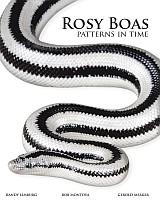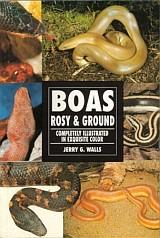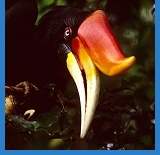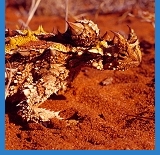




Related bibliographies:
Reptiles
 Snakes Snakes
 Boidae Boidae
North America






































































































































































































































































































































| |

Bibliography of the genus
Lichanura (Rosy Boas)

(Reptilia: Serpentes: Boidae)
Note:
In order to limit redundancy, relevant literature indexed in the related bibliographies in the left column may not have been included in this page. For a comprehensive search of literature, these bibliographies should therefore also be consulted.
Lichanura in general
 |
Klauber, L.M. 1933. Notes on Lichanura. Copeia 1933: 214-215.
Limburg, R.; Montoya, B.; Merker, G. 2011. Rosy Boas - Patterns in Time. ECO Herpetological Publishing, Rodeo, New Mexico. 192 pp.
McLain, J.M. 1983. Boid snakes of the world. 1. North American boas. Freshwater and Marine Aquarium 6(5): 38-39, 57.
Mills, M. 1989. Maintaining Lichanura in captivity. Litteratura Serpentium (English Edition) 9(1): 45-47.
Walls, J.G. 1994. Rosy and Ground Boas. T.F.H. Publications, Neptune City, New Jersey. 64 pp.
Yingling, R.P. 1982. Lichanura. Catalogue of American Amphibians and Reptiles 294: 1-2.
|
Lichanura orcutti
 |
Wood, D.A.; Rochester, C.J.; Fisher, R.N. 2008. Natural history notes: Lichanura orcutti (Rosy Boa). Predation. Herpetological Review 39(3): 354-355.
|
Lichanura trivirgata
 |
Applegate, R.; Witwer, M. 1997. Safe water bowls for neonate snakes. Bulletin of the Chicago Herpetological Society 32(1): 6.
Arnaud, G.; Blázquez, M.C. 2018. First record of Lichanura trivirgata Cope, 1868 (Squamata: Boidae) from Coronados Island, Gulf of California, Mexico. Herpetology Notes 11: 1025-1026.
Brennan, T.C.; Feldner, M.J. 2001. Geographic distribution: Lichanura trivirgata trivirgata (Mexican Rosy Boa). Herpetological Review 32(3): 196.
Brodie, E.D. 1989. Individual variation in antipredator response of Ambystoma jeffersonianum to snake predators. Journal of Herpetology 23(3): 307-309.
Clark, R.W.; Ramirez, G. 2011. Rosy boas (Lichanura trivirgata) use chemical cues to identify female mice (Mus musculus) with litters of dependent young. Herpetological Journal 21(3): 187-191.
Diffendorfer, J.E.; Rochester, C.; Fisher, R.N.; Brown, T.K. 2005. Movement and space use by coastal Rosy Boas (Lichanura trivirgata roseofusca) in coastal southern California. Journal of Herpetology 39(1): 24-36.
Douglas, D.A.; Gower, D.J. 2010. Snake mitochondrial genomes: phylogenetic relationships and implications of extended taxon sampling for interpretations of mitogenomic evolution. BMC Genomics 11(14): 1-16.
Feldner, J.J. 1992. Geographic distribution: Lichanura trivirgata gracia (Desert Rosy Boa). USA: California: Imperial Co. Herpetological Review 23(4): 124.
Frick, W.F.; Heady, P.A.; Hollingsworth, B.D. 2016. Geographic distribution: Lichanura trivirgata (Rosy Boa). Herpetological Review 47(1): 83-84.
Gorman, G.C. 1965. The distribution of Lichanura trivirgata and the status of the species. Herpetologica 21: 283-287.
Gorman, G.C.; Gress, F. 1970. Chromosome cytology of four boid snakes and a varanid lizard, with comments on the cytosystematics of primitive snakes. Herpetologica 26: 308-316.
Hensley, M.M. 1950. Results of a herpetological reconnaissance in extreme southwestern Arizona and adjacent Sonora, with a description of a new subspecies of the Sonoran whipsnake, Masticophis bilineatus. Transactions of the Kansas Academy of Sciences 53: 270-288.
Herritt, M.C. 2017. Geographic distribution: Lichanura trivirgata (Three-line Boa). Herpetological Review 48(4): 814.
Klauber, L.M. 1931. A new subspecies of the California Boa, with notes on the genus Lichanura. Transactions of the San Diego Society of Natural History 6: 305-318.
Kurfess, J.F. 1967. Mating, gestation, and growth rate in Lichanura r. roseofusca. Copeia 1967: 477-478.
Lisle, H.F. de 1977. The rosy boa Lichanura trivirgata. Herpetology 9(3): 9-12.
Lynum, P.; Pike, J. 2013. Geographic distribution: Lichanura trivirgata trivirgata (Mexican Rosy Boa). Herpetological Review 44(2): 275.
Mackale, P. 2006. Keeping the Rosy Boa Lichanura trivirgata trivirgata. Herptile 31(3): 73-75.
Markx, T. 1987. Lichanura trivirgata roseofusca - rosy boa. Litteratura Serpentium (English Edition) 7(1): 46-47.
Mazzarella, D.B. 1974. Growth rate of Lichanura r. roseofusca in captivity. Bulletin Md herpet. American Philosophical Society Yearbook 10(4): 115-117.
Medina, D.R. 1959. Observations on the feeding behavior of a captive Rosy Boa. Lichanura roseafusca. Copeia 1959: 336.
Meer, J. van het 1996. Keeping, breeding and caring for Lichanura. Litteratura Serpentium (English Edition) 16(3): 64-70.
Mehta, R.S.; Burghardt, G.M. 2008. Contextual flexibility: reassessing the effects of prey size and status on prey restraint behaviour of macrostomate snakes. Ethology 114(2): 133-145.
Merker, G.; Merker, C. 2001. The Rosy Boa: the ultimate pet boid. Reptile & Amphibian Hobbyist 6(11): 8-21.
Mulks, M. 2011. Geographic distribution: Lichanura trivirgata gracia (Desert Rosy Boa). Herpetological Review 42(1): 115.
Ottley, J.R. 1978. A new subspecies of the snake Lichanura trivirgata from Cedros Island, Mexico. Great Basin Naturalist 38(4): 411-416.
Ottley, J.R.; Murphy, R.W.; Smith, G.V. 1980. The taxonomic status of the rosy boa Lichanura roseofusca (Serpentes: Boidae). Great Basin Naturalist 40(1): 59-62.
Pequegnat, W.E. 1951. The biota of the Santa Ana Mountains. Journal Ent. Zool. 42: 1-84.
Pols, J. van der 1986. Breeding results. Lichanura trivirgata roseofusca. Litteratura Serpentium (English Edition) 6(1): 43.
Pols, J. van der 1986. The husbandry and breeding of the rosy boa Lichanura trivirgata roseofusca (Cope, 1861). Litteratura Serpentium (English Edition) 6(3): 98-106.
Powers, A.L.; Banta, B.H. 1976. Lichanura trivirgata Cope recorded from Cerralvo Island, Gulf of California, Mexico. American Philosophical Society Yearbook 12(4): 119-121.
Reynoso, F. 1990. Geographic distribution: Lichanura trivirgata trivirgata (Mexican Rosy Boa). Herpetological Review 21(1): 23.
Schoenig, E.J.; Dayton, G.H. 2017. Geographic distribution: Lichanura trivirgata (Rosy Boa). Herpetological Review 48(1): 128-129.
Switak, K.H. 1997. Zwergboas Nordamerikas. In Natur und Terrarium. TI-Magazin 138: 39-44.
Turner, F.B. 1959. New localities for Lichanwa roseofusca gracia in Inyo County, California. Copeia 1959: 172.
Walker, H. 2014. Rosy boas. Care and breeding. Herptile 39(3): 101-105.
Welsh, H.H.; Bury, R.B. 1984. Additions to the herpetofauna of the southern Colorado Desert, Baja California, with comments on the relationships of Lichanura trivirgata. Herpetological Review 15(2): 53-56.
West, Z.; Lauermann, J. 2010. Geographic distribution: Lichanura trivirgata roseofusca (Coastal Rosy Boa). USA: California. Herpetological Review 41(3): 380-381.
Witwer, M. 1996. Rosy boas. Reptile & Amphibian Magazine 43: 58-69.
Wood, D.A.; Fisher, R.N.; Reeder, T.W. 2008. Novel patterns of historical isolation, dispersal, and secondary contact across Baja California in the Rosy Boa (Lichanura trivirgata). Molecular Phylogenetics and Evolution 46(2): 484-502.
Wright, A.H. 1921. The California or Rosy Boa (Lichanura roseofusca Cope). Copeia 95: 35-36.
Zweifel, R.G.; Norris, K.S. 1955. Contribution to the herpetology of Sonora, Mexico: descriptions of new subspecies of snakes (Micruroides euryxanthus and Lampropeltis getulus) and miscellaneous collecting notes. American Midland Naturalist 54: 230-249.
|
| | 
















































































































































































|

